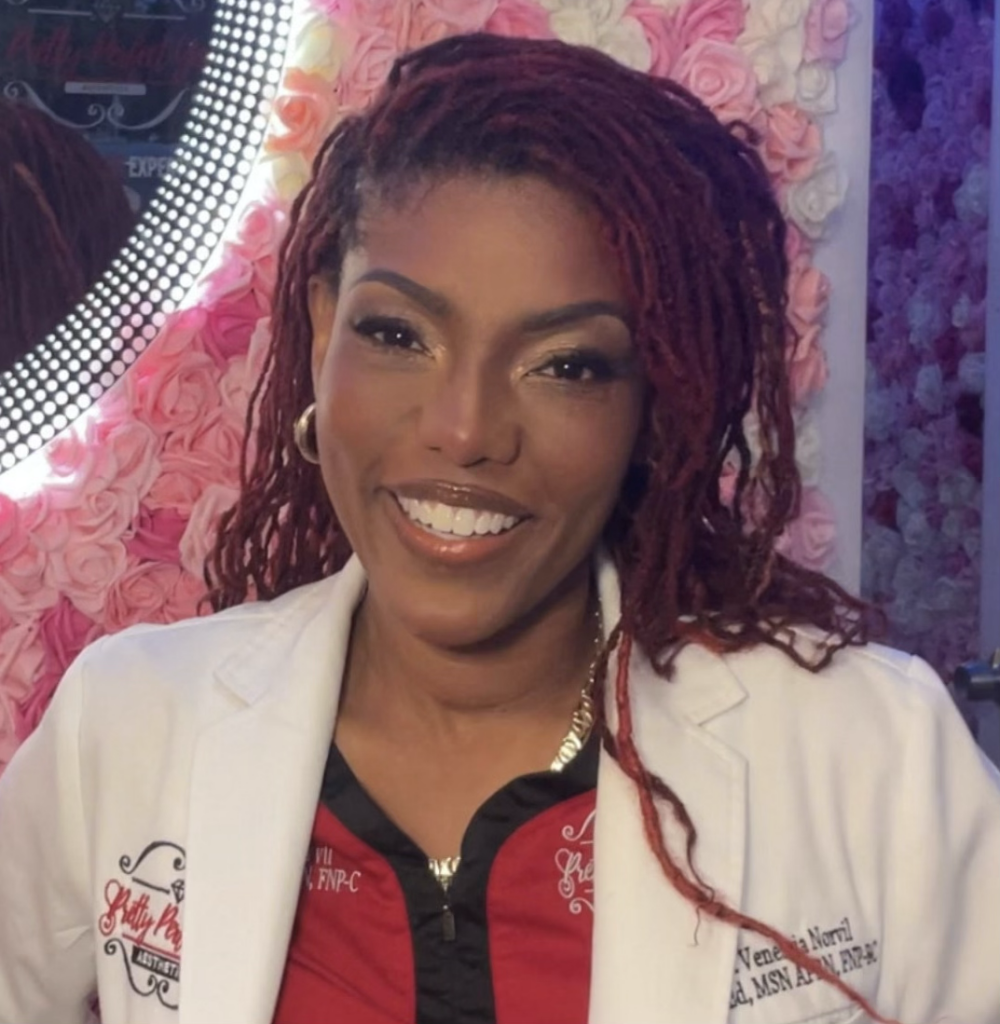Day in the Life of an Aesthetic Nurse Practitioner
Find NP Schools
For the 2023-2024 academic year, we have 140 NP schools in our database and those that advertise with us are labeled “sponsor”. When you click on a sponsoring school or program, or fill out a form to request information from a sponsoring school, we may earn a commission. View our advertising disclosure for more details.
“My absolute favorite part of being an aesthetic nurse practitioner is seeing the transformation in my patients’ confidence.”
Venessia Norvil, MSN, Owner of Pretty Perfect You
Aesthetics has become a very popular specialty for NPs in recent years. Aesthetic NPs specialize in cosmetic medical procedures that improve patients’ appearances. It can be a competitive specialty requiring devotion, experience, and networking. Being an aesthetic NP is less stressful than working in other specialties, and it offers a generous salary and regular working hours. There are also plenty of opportunities for aesthetic NPs to practice autonomously and own their medical aesthetics practice.
Aesthetic NPs’ focus on refining patients’ physical appearances and confidence. They examine and evaluate patients, educate them on their procedure options, answer their questions, perform those procedures, and monitor them for adverse reactions. Cosmetic procedures can make a huge difference in how patients feel about themselves.
Meet the Expert: Venessia Norvil, MSN

Venessia Norvil is a nurse practitioner who specializes in aesthetics. She owns her own medical spa, Pretty Perfect You. She obtained her MSN APRN from Chamberlain University and her MSN in education from Western Governors University.
At Norvil’s practice, she offers a wide range of aesthetic services to help patients look and feel their best. These include Botox and dermal fillers, rejuvenating chemical peels, laser treatments for smooth skin and hair removal, micro needling for a fresh, youthful glow, PRP (Platelet-Rich Plasma) therapy, and personalized skin care consultations. She also specializes in non-surgical facelifts, using the latest techniques to enhance a patient’s natural beauty without the need for surgery.
The Role of Aesthetic NPs
Aesthetic NPs work in outpatient settings such as medical spas or private practice clinics. They can perform several clinical procedures. They inject dermal fillers or Botox to improve the appearance of wrinkles and crow’s feet. These injections can also make lips look fuller and counter the effects of aging. Some fillers help patients have a more pronounced jaw line or chin. While other injectables are used as fat reducers such as Kybella, which breaks down double chin fat. Injectables can also be used to treat TMJ or chronic jaw pain.
“My absolute favorite part of being an aesthetic nurse practitioner is seeing the transformation in my patients’ confidence,” says Norvil. “There is nothing like the moment when a patient looks in the mirror and smiles because they feel great about themselves.”
Aesthetic NPs perform laser therapy such as tattoo removal and laser hair removal. They also provide skin treatments such as facials, microdermabrasion, and chemical peels. They offer sclerotherapy treatments which eliminate varicose veins through the injection of a solution in the veins. They may also offer cool sculpting which helps patients lose weight and breaks down fat tissue.
Additionally, NPs may work collaboratively with dermatologists or plastic surgeons and assist in performing surgeries, administering procedures, and/or manage patient education and recovery. They consult with patients to perform medical screenings and prepare them for the procedure. They provide education and explain what to expect from the procedure. Another benefit is that aesthetic NPs have the opportunity to build relationships with repeat patients.
“I also love the creative aspect of the job—it’s like being an artist, but with the human face and body as my canvas,” says Norvil. “Plus, I get to stay on the cutting edge of beauty and wellness trends, which is endlessly fascinating.”
Aesthetic NP Training
To become an aesthetic NP, nurses need to continue their education and earn a master’s of science in nursing or a doctorate in nursing practice degree. Afterwards, NPs should work with dermatologists or plastic surgeons to gain new skills. NPs can take courses on Botox and other injections to learn how to provide these services. Some programs offer live patient injector training to learn proper dosing and delivery.
“The best way to become an aesthetic NP is to start with a solid nursing background and then dive into specialized training in aesthetics,” says Norvil. “This means attending workshops, getting certifications from reputable organizations, and gaining hands-on experience under the guidance of seasoned practitioners.”
Aesthetic NPs should demonstrate proficiency in administering injectables such as Botox and fillers. They should be able to communicate effectively to convey treatment details with their patients. They should have a desire for continuous learning to stay up to date on evolving medical processes.
“Networking with other professionals and staying current with industry trends through conferences and professional groups is also key to your growth and success,” says Norvil.
Norvil recommends the following tips for NPs interested in working in aesthetics:
- “Seek out experience in dermatology or plastic surgery settings to build a strong foundation.”
- “Invest in top-notch training programs and earn your certifications.”
- “Start by mastering a couple of procedures before branching out to others.”
- “Cultivate a robust professional network—relationships in this field are invaluable.”
- “Educate your patients thoroughly and set clear, realistic expectations.”
- “Always prioritize safety and ethical practice in your work.”
- “Keep your passion for learning alive; the industry is always evolving, and so should you.”
Career Outlook
Prospects and careers as an aesthetic NP are rising rapidly as medical spas and facial procedures continue to gain popularity. According to Incredible Health, the aesthetics injectable market will continue to grow at least 12 percent per year for the next five years. Both men and women are looking to counter the effect of aging on their appearance, and the use of Botox and filler has become widely accepted.
“The future for aesthetic NPs is incredibly bright,” Norvil says. “With the increasing demand for non-surgical cosmetic procedures, there are endless opportunities for growth and specialization. Technological advancements will continue to introduce exciting new treatments, offering even more ways to help patients achieve their aesthetic goals.”
Currently there are no NP programs dedicated specifically to becoming an aesthetic NP. Those interested in this specialty can earn their family NP or adult NP degrees and then train with an experienced aesthetics NPs or physician. Many medical spa owners are interested in training new hires and helping them learn the skills needed to succeed.
“As the field expands, aesthetic NPs will gain more recognition and autonomy, opening doors for professional development and innovation,” Norvil says. “It is an exciting time to be in this specialty!”
Challenges in Aesthetics
Being an Aesthetic NP can have its own set of challenges. Opening a new practice can be difficult as NPs try to build up their client base and reputation. NPs should focus on marketing initially to grow their business. Practicing in aesthetic medicine can be isolating due to NPs often practicing solo. NPs should try to network with peers and attend training courses with like-minded medical staff.
“One of the biggest challenges as an aesthetic NP is managing patient expectation,” says Norvil. “It is crucial to ensure they understand the realistic outcomes and potential risks of their chosen treatments. On top of that, navigating the business and regulatory aspects of the practice requires careful attention to detail and continuous education.”
NPs should spend time thinking about the patient’s mindset and goals. They should understand what patients are trying to achieve. Then they should be honest about what kind of results the patient can expect.
Resources for Aesthetic NPs
To learn more about education, practice, and advocacy of aesthetic NPs, check out some of the resources below:
- The American Academy of Aesthetic Medicine (AAAM): Founded in 1999, AAAM is the first global leader in Aesthetic Medicine. It is devoted to teaching providers how to develop or expand their aesthetic medicine practice. AAAM provides education and hands-on training to its members and updates them with the latest scientific knowledge.
- The American Association of Aesthetic Medicine and Surgery (AAAMS): The AAAMS is dedicated to training NPs and other medical professionals in the art of aesthetics. NPs can enroll in their program to learn necessary aesthetic skills. They teach medical and surgical aesthetics using a hybrid learning method, by combining online learning and hands-on training.
- American Med Spa Association (AmSpa): AmSpa is an association for nurse practitioners, physicians, and registered nurses interested in the medical aesthetic industry. It consists of a safety council that guides practices in making sure their medical spas are legally compliant and safe for patients. It also offers medspa owners insight and feedback on their practices.
- International Association for Physicians in Aesthetic Medicine (IAPAM): Organizations such as IAPAM train nurse practitioners in aesthetic medicine. This includes Botox, dermal filler, microdermabrasion, chemical peel, and laser training.

Sophia Khawly, MSN
WriterSophia Khawly is a traveling nurse practitioner from Miami, Florida. She has been a nurse for 14 years and has worked in nine different states. She likes to travel in her spare time and has visited over 40 countries.
Being a traveling nurse practitioner allows her to combine her love of learning, travel, and serving others. Learn more about Sophia at www.travelingNP.com.